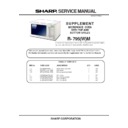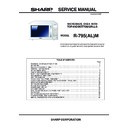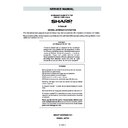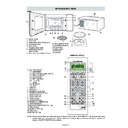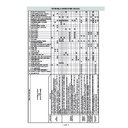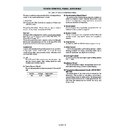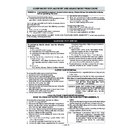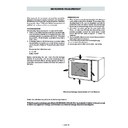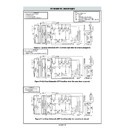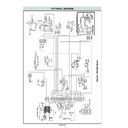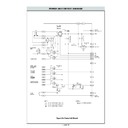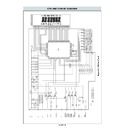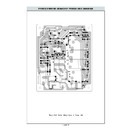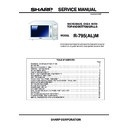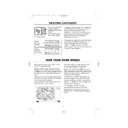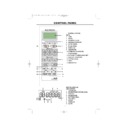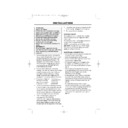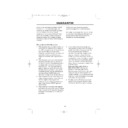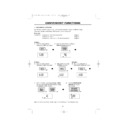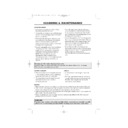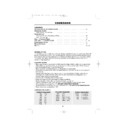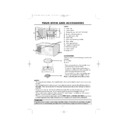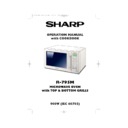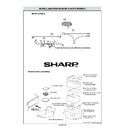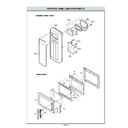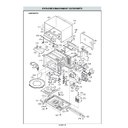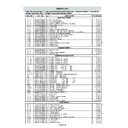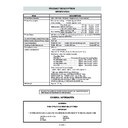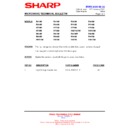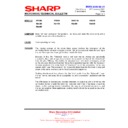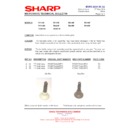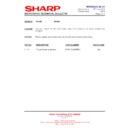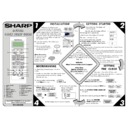Sharp R-795M (serv.man26) User Manual / Operation Manual ▷ View online
30
DEFROSTING ADVICE
Defrosting food using your microwave oven is
the quickest method of all.
the quickest method of all.
It is a simple proccess but the following
instructions are essential to ensure the food is
thoroughly defrosted.
instructions are essential to ensure the food is
thoroughly defrosted.
NOTES:
• Remove all packaging and wrapping before defrosting.
• To defrost food, use microwave power levels 30% or 10%.
• Please refer to the defrosting chart on page 37 for further information.
• Remove all packaging and wrapping before defrosting.
• To defrost food, use microwave power levels 30% or 10%.
• Please refer to the defrosting chart on page 37 for further information.
Rearrange
Separate
Shield
Stand
Turn over
Foods that are placed towards the outside of the dish will defrost quicker than
foods in the centre. It is therefore essential that the food is rearranged up to 4
times during defrosting.
Move closely packed pieces from the outside to the centre and rearrange
over-lapping areas.
This will ensure that all parts of the food defrosts evenly.
foods in the centre. It is therefore essential that the food is rearranged up to 4
times during defrosting.
Move closely packed pieces from the outside to the centre and rearrange
over-lapping areas.
This will ensure that all parts of the food defrosts evenly.
Foods may be stuck together when removed from the freezer. It is important
to separate foods as soon as it is possible during defrosting.
e.g. bacon rashers, chicken fillets.
to separate foods as soon as it is possible during defrosting.
e.g. bacon rashers, chicken fillets.
Some areas of food being defrosted may become warm. To prevent them
becoming warmer and starting to cook, these areas can be shielded with small
pieces of foil, which reflect microwaves. e.g. legs and wings on a chicken.
becoming warmer and starting to cook, these areas can be shielded with small
pieces of foil, which reflect microwaves. e.g. legs and wings on a chicken.
Standing time is necessary to ensure food is thoroughly defrosted.
Defrosting is not complete once the food is removed from the microwave
oven. Food must stand, covered, for a length of time to ensure the centre has
completley defrosted.
Defrosting is not complete once the food is removed from the microwave
oven. Food must stand, covered, for a length of time to ensure the centre has
completley defrosted.
It is essential that all foods are turned over up to 4 times during defrosting.
This is important to ensure thorough defrosting.
This is important to ensure thorough defrosting.
R-795M New style Op man 4/8/02 9:21 AM Page 30
31
Plated meals
Sliced meat
Poultry portions
Casseroles
Remove any poultry or meat portions, reheat
these separately, see below.
Place smaller items of food to the centre of the plate,
larger and thicker foods to the edge. Cover with vented
microwave cling film and reheat on 50%, stir/rearrange
halfway through reheating.
NOTE: Ensure the food is thoroughly reheated before
these separately, see below.
Place smaller items of food to the centre of the plate,
larger and thicker foods to the edge. Cover with vented
microwave cling film and reheat on 50%, stir/rearrange
halfway through reheating.
NOTE: Ensure the food is thoroughly reheated before
serving.
Cover with vented microwave cling film and reheat on
50%. Rearrange at least once to ensure even reheating.
NOTE: Ensure the meat is thoroughly reheated before
50%. Rearrange at least once to ensure even reheating.
NOTE: Ensure the meat is thoroughly reheated before
serving.
Place thickest parts of the portions to the outside of the
dish, cover with vented microwave cling film and reheat
on 70%.
Turn over halfway through reheating.
NOTE: Ensure the poultry is thoroughly reheated
dish, cover with vented microwave cling film and reheat
on 70%.
Turn over halfway through reheating.
NOTE: Ensure the poultry is thoroughly reheated
before serving.
Cover with vented microwave cling film or a suitable lid
and reheat on 50%.
Stir frequently to ensure even reheating.
NOTE: Ensure the food is thoroughly reheated before
and reheat on 50%.
Stir frequently to ensure even reheating.
NOTE: Ensure the food is thoroughly reheated before
serving.
REHEATING ADVICE
For the reheating of foods, follow the advice and guidelines below to ensure food is thoroughly
reheated before serving.
reheated before serving.
NOTES:
• Remove food from foil or metal containers before reheating.
• Reheating times will be affected by the shape, depth, quantity and temperature of food together with
• Remove food from foil or metal containers before reheating.
• Reheating times will be affected by the shape, depth, quantity and temperature of food together with
the size, shape and material of the container.
• To avoid overheating and fire, special care must be taken when reheating foods with a high sugar or
fat content, e.g. mince pies or Christmas pudding.
• Never heat oil or fat for deep frying as this may lead to overheating and fire.
• Canned potatoes should not be heated in the microwave oven, follow the manufacturer’s
• Canned potatoes should not be heated in the microwave oven, follow the manufacturer’s
instructions on the can.
To achieve the best results when reheating, select a suitable microwave power level appropriate to the
type of food. e.g. A bowl of vegetables can be reheated using 100%, while a lasagne which contains
ingredients that cannot be stirred, should be reheated using 50%.
type of food. e.g. A bowl of vegetables can be reheated using 100%, while a lasagne which contains
ingredients that cannot be stirred, should be reheated using 50%.
Never heat liquids in narrow-necked containers, as this could result in the
contents erupting from the container and may cause burns.
contents erupting from the container and may cause burns.
The contents of feeding bottles and baby food jars are to be stirred or shaken and
the temperature is to be checked before consumption to avoid burns.
the temperature is to be checked before consumption to avoid burns.
R-795M New style Op man 4/8/02 9:21 AM Page 31
31
Plated meals
Sliced meat
Poultry portions
Casseroles
Remove any poultry or meat portions, reheat
these separately, see below.
Place smaller items of food to the centre of the plate,
larger and thicker foods to the edge. Cover with vented
microwave cling film and reheat on 50%, stir/rearrange
halfway through reheating.
NOTE: Ensure the food is thoroughly reheated before
these separately, see below.
Place smaller items of food to the centre of the plate,
larger and thicker foods to the edge. Cover with vented
microwave cling film and reheat on 50%, stir/rearrange
halfway through reheating.
NOTE: Ensure the food is thoroughly reheated before
serving.
Cover with vented microwave cling film and reheat on
50%. Rearrange at least once to ensure even reheating.
NOTE: Ensure the meat is thoroughly reheated before
50%. Rearrange at least once to ensure even reheating.
NOTE: Ensure the meat is thoroughly reheated before
serving.
Place thickest parts of the portions to the outside of the
dish, cover with vented microwave cling film and reheat
on 70%.
Turn over halfway through reheating.
NOTE: Ensure the poultry is thoroughly reheated
dish, cover with vented microwave cling film and reheat
on 70%.
Turn over halfway through reheating.
NOTE: Ensure the poultry is thoroughly reheated
before serving.
Cover with vented microwave cling film or a suitable lid
and reheat on 50%.
Stir frequently to ensure even reheating.
NOTE: Ensure the food is thoroughly reheated before
and reheat on 50%.
Stir frequently to ensure even reheating.
NOTE: Ensure the food is thoroughly reheated before
serving.
REHEATING ADVICE
For the reheating of foods, follow the advice and guidelines below to ensure food is thoroughly
reheated before serving.
reheated before serving.
NOTES:
• Remove food from foil or metal containers before reheating.
• Reheating times will be affected by the shape, depth, quantity and temperature of food together with
• Remove food from foil or metal containers before reheating.
• Reheating times will be affected by the shape, depth, quantity and temperature of food together with
the size, shape and material of the container.
• To avoid overheating and fire, special care must be taken when reheating foods with a high sugar or
fat content, e.g. mince pies or Christmas pudding.
• Never heat oil or fat for deep frying as this may lead to overheating and fire.
• Canned potatoes should not be heated in the microwave oven, follow the manufacturer’s
• Canned potatoes should not be heated in the microwave oven, follow the manufacturer’s
instructions on the can.
To achieve the best results when reheating, select a suitable microwave power level appropriate to the
type of food. e.g. A bowl of vegetables can be reheated using 100%, while a lasagne which contains
ingredients that cannot be stirred, should be reheated using 50%.
type of food. e.g. A bowl of vegetables can be reheated using 100%, while a lasagne which contains
ingredients that cannot be stirred, should be reheated using 50%.
Never heat liquids in narrow-necked containers, as this could result in the
contents erupting from the container and may cause burns.
contents erupting from the container and may cause burns.
The contents of feeding bottles and baby food jars are to be stirred or shaken and
the temperature is to be checked before consumption to avoid burns.
the temperature is to be checked before consumption to avoid burns.
R-795M New style Op man 4/8/02 9:21 AM Page 31
31
Plated meals
Sliced meat
Poultry portions
Casseroles
Remove any poultry or meat portions, reheat
these separately, see below.
Place smaller items of food to the centre of the plate,
larger and thicker foods to the edge. Cover with vented
microwave cling film and reheat on 50%, stir/rearrange
halfway through reheating.
NOTE: Ensure the food is thoroughly reheated before
these separately, see below.
Place smaller items of food to the centre of the plate,
larger and thicker foods to the edge. Cover with vented
microwave cling film and reheat on 50%, stir/rearrange
halfway through reheating.
NOTE: Ensure the food is thoroughly reheated before
serving.
Cover with vented microwave cling film and reheat on
50%. Rearrange at least once to ensure even reheating.
NOTE: Ensure the meat is thoroughly reheated before
50%. Rearrange at least once to ensure even reheating.
NOTE: Ensure the meat is thoroughly reheated before
serving.
Place thickest parts of the portions to the outside of the
dish, cover with vented microwave cling film and reheat
on 70%.
Turn over halfway through reheating.
NOTE: Ensure the poultry is thoroughly reheated
dish, cover with vented microwave cling film and reheat
on 70%.
Turn over halfway through reheating.
NOTE: Ensure the poultry is thoroughly reheated
before serving.
Cover with vented microwave cling film or a suitable lid
and reheat on 50%.
Stir frequently to ensure even reheating.
NOTE: Ensure the food is thoroughly reheated before
and reheat on 50%.
Stir frequently to ensure even reheating.
NOTE: Ensure the food is thoroughly reheated before
serving.
REHEATING ADVICE
For the reheating of foods, follow the advice and guidelines below to ensure food is thoroughly
reheated before serving.
reheated before serving.
NOTES:
• Remove food from foil or metal containers before reheating.
• Reheating times will be affected by the shape, depth, quantity and temperature of food together with
• Remove food from foil or metal containers before reheating.
• Reheating times will be affected by the shape, depth, quantity and temperature of food together with
the size, shape and material of the container.
• To avoid overheating and fire, special care must be taken when reheating foods with a high sugar or
fat content, e.g. mince pies or Christmas pudding.
• Never heat oil or fat for deep frying as this may lead to overheating and fire.
• Canned potatoes should not be heated in the microwave oven, follow the manufacturer’s
• Canned potatoes should not be heated in the microwave oven, follow the manufacturer’s
instructions on the can.
To achieve the best results when reheating, select a suitable microwave power level appropriate to the
type of food. e.g. A bowl of vegetables can be reheated using 100%, while a lasagne which contains
ingredients that cannot be stirred, should be reheated using 50%.
type of food. e.g. A bowl of vegetables can be reheated using 100%, while a lasagne which contains
ingredients that cannot be stirred, should be reheated using 50%.
Never heat liquids in narrow-necked containers, as this could result in the
contents erupting from the container and may cause burns.
contents erupting from the container and may cause burns.
The contents of feeding bottles and baby food jars are to be stirred or shaken and
the temperature is to be checked before consumption to avoid burns.
the temperature is to be checked before consumption to avoid burns.
R-795M New style Op man 4/8/02 9:21 AM Page 31
Display


